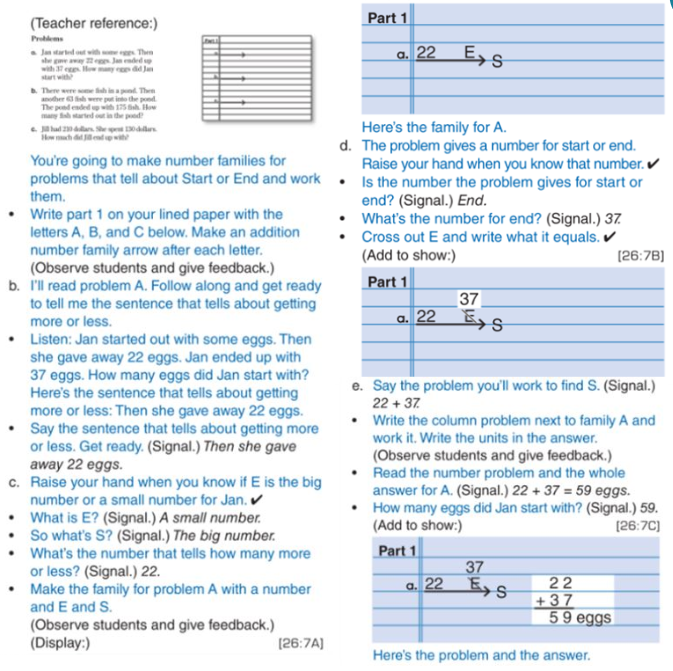Teach Connecting Math Concepts E (5)
-
Module introduction5 Topics
-
Overview25 Topics|3 Tests
-
Cover
-
Lesson objective
-
Opening the lesson
-
Direct Instruction overview
-
CMC overview
-
Teacher’s role in motivation
-
Affirmations
-
CMC E materials
-
Time requirements
-
Placement testing
-
Check Your Understanding
-
Grouping, seating, STAR, transitions
-
Routines for transitions
-
Script features
-
Script with brackets
-
Abbreviated scripts
-
Call on individual students
-
Check Your Understanding
-
RMSE LA K-Individual Turns
-
Board work
-
Lined-paper icons
-
Maths learning behaviours
-
Test Your Understanding
-
Review
-
Lesson completed!
-
Cover
-
Connecting CMC to Oz-e-maths15 Topics|2 Tests
-
Addition number families22 Topics|2 Tests
-
Cover
-
Lesson objective
-
Opening the lesson
-
Auditory signal
-
Auditory signal
-
Number families
-
Corrections and repeat until firm
-
Active monitoring
-
Active monitoring
-
New direction
-
Number family computation
-
Corrections spoken and written
-
Comparison word problems
-
Check Your Understanding
-
Sequence word problems
-
Abbreviated skip boxes
-
Sequence word problems with abbreviated skip box
-
Classification word problems
-
Corrections for number families
-
Test Your Understanding
-
Review
-
Lesson completed!
-
Cover
-
Multiplication number families and facts21 Topics|2 Tests
-
Cover
-
Lesson objective
-
Opening the lesson
-
Multiplication families
-
Point-touch signal
-
Point-touch signal
-
Multiplication family: word problems overview
-
Multiplication family: times word problems
-
Multiplication family: each/every word problems
-
Multiplication family: unit measurement/fact word problems
-
Check Your Understanding
-
Corrections for multiplication number families
-
The tick
-
Facts explained
-
Multiplying by 9
-
Droning and corrections
-
New fact families
-
Corrections for facts
-
Test Your Understanding
-
Review
-
Lesson completed!
-
Cover
-
Fractions and whole numbers17 Topics|2 Tests
-
Cover
-
Lesson objective
-
Opening the lesson
-
Basic fraction analysis explained
-
Basic fraction analysis
-
Fractions lesson thirty-one
-
Fractions lesson forty-two
-
Fraction multiplication
-
Equivalent fractions
-
Corrections
-
Whole numbers
-
Script success
-
Check Your Understanding
-
Test Your Understanding
-
Lesson practice
-
Review
-
Lesson completed!
-
Cover
-
Decimal, Per cent and Geometry18 Topics|2 Tests
-
Cover
-
Lesson Objective
-
Opening the Lesson
-
Decimal and Per cent Overview
-
Decimals
-
Per cents
-
Corrections
-
Geometry Overview
-
Perimeter – Area
-
Angles
-
Supplementary and Vertical Angles
-
Protractors
-
Call on Individual Students
-
Check Your Understanding
-
Test Your Understanding
-
Video: Demonstration
-
Review
-
Lesson Completed!
-
Cover
-
Column subtraction, multiplication and division21 Topics|2 Tests
-
Cover
-
Lesson objective
-
Opening the lesson
-
Auditory signal
-
Auditory signal
-
Column subtraction types
-
Column subtraction
-
Column subtraction doubling
-
Point-touch signal
-
Point – Touch Signal
-
Column multiplication overview
-
Multiplying 2-digit by 1-digit numbers
-
Multiplying by tens
-
Corrections
-
Division
-
Remainders
-
Interior remainders
-
Check Your Understanding
-
Test Your Understanding
-
Review
-
Lesson completed!
-
Cover
-
Rounding, estimation, coefficients, inverse operations and mixed-number computations17 Topics|2 Tests
-
Cover
-
Lesson objective
-
Opening the lesson
-
Rounding and estimation
-
Rounding
-
Rounding to tens, hundreds and thousands
-
Coefficients
-
Inverse operations
-
Corrections
-
Mixed number computations
-
Adding – subtracting
-
Multiplying mixed numbers with whole numbers
-
Observe students and give feedback
-
Check Your Understanding
-
Test Your Understanding
-
Review
-
Lesson completed!
-
Cover
-
Coordinate system and functions, ratio word problems and prime factors19 Topics|2 Tests
-
Cover
-
Lesson objective
-
Opening the lesson
-
Point-touch signal
-
Point – Touch Signal
-
Coordinate systems
-
Functions
-
Fractional coefficients
-
Ratio word problems
-
Each/every
-
Check Your Understanding
-
Fraction wording
-
Prime factors
-
Multiples
-
Prime numbers
-
Composite numbers
-
Test Your Understanding
-
Review
-
Lesson completed!
-
Cover
-
Motivating students and independent work20 Topics|2 Tests
-
Cover
-
Lesson objective
-
Opening the lesson
-
Basis of student motivation
-
The importance of monitoring responses
-
Providing affirmations
-
Affirmations
-
Communicate in a positive manner
-
Specific positive feedback
-
Using specific positive praise
-
Independent work
-
Independent work expectations
-
Work checks
-
Work checks for independent work
-
Conducting work checks
-
Work-checks
-
Check Your Understanding
-
Test Your Understanding
-
Review
-
Lesson completed!
-
Cover
-
Mastery tests24 Topics|2 Tests
-
Cover
-
Lesson objective
-
Opening the lesson
-
Conducting mastery tests
-
Mastery tests
-
Using mastery test information
-
Mastery test criterion
-
Providing remedies
-
Determining who needs remediation and retesting
-
Mastery tests on SPT
-
Inputting Data
-
Cumulative tests
-
Flight path concept
-
Check Your Understanding
-
Expected lesson pacing
-
Lesson progress on SPT
-
Pacing of instruction
-
Effective transitions
-
Lesson pacing and transitions
-
Teaching routines
-
Effective routines
-
Test Your Understanding
-
Review
-
Lesson completed!
-
Cover
-
Bringing it all together28 Topics|2 Tests
-
Cover
-
Lesson objective
-
Opening the lesson
-
Auditory signal
-
Auditory signal
-
Corrections and repeat until firm
-
Correction tips
-
Lesson 42, exercise 1
-
Point-touch signal
-
Point – Touch Signal
-
Lesson 42, exercise 2
-
Lesson 42, exercise 3
-
Abbreviated skip boxes
-
Lesson 42, exercise 4
-
Lesson 42, exercise 5
-
Lesson 42, exercise 6 with textbook practice
-
Corrections spoken and written
-
Lined-paper icons
-
Lesson 42, exercise 7
-
Lesson 42, exercise 8
-
Lesson 42, exercise 9
-
Lesson 42, exercise 10
-
Script success
-
Check Your Understanding
-
Test Your Understanding
-
Lesson practice
-
Review
-
Lesson completed!
-
Cover
-
Module evaluation survey1 Topic
Participants 533
Sequence word problems
ddewell@goodtogreatschools.org.au August 7, 2023

Sequence word problems
Sequence word problems begin in lesson nineteen. In lesson twenty-six full sequence word problems begin.
The strategy students follow is to find the sentence in the problem that tells about getting more or less. The sentence has information about whether the end is the big number or a small number. The sentence also gives the first small number in the family.


The process is:
- The teacher says, ‘You’re going to make number families for problems that tell about Start or End and work them. Write part one on your lined paper with the letters A, B and C below. Make an addition number family arrow after each letter’, and observes students and gives feedback.
- The teacher says, ‘I’ll read problem A. Follow along and get ready to tell me the sentence that tells about getting more or less. Listen: Jan started out with some eggs. Then she gave away twenty-two eggs. Jan ended up with thirty-seven eggs. How many eggs did Jan start with? Here’s the sentence that tells about getting more or less: Then she gave away twenty-two eggs. Say the sentence that tells about getting more or less. Get ready’ and signals (auditory).
- The teacher says, ‘Raise your hand when you know if E is the big number or a small number for Jan’ and scans students. ‘What is E?’ and signals (auditory). ‘What is S?’ and signals (auditory).
- The teacher says, ‘What’s the number that tells how many more or less?’ and signals (auditory).
- The teacher says, ‘Make the family for problem A with a number and E and S’ and observes students and gives feedback.
- The teacher continues to work through the problem, guiding the students with the questions for each step.
Students have worked all parts of the problem. This is the first time they are putting all the parts together. There are a lot of steps but if the students start with what sentence tells more or less, they have the framework for a start-end problem. If students get confused or stuck, the teacher reminds them of the steps.
Turn to page 55 in CMC E Teacher’s Guide. Practise teaching lesson 26, exercise 7 with no student errors

